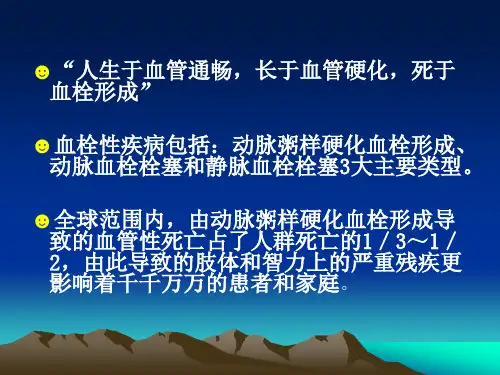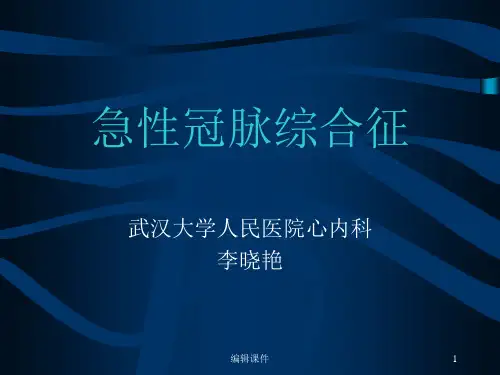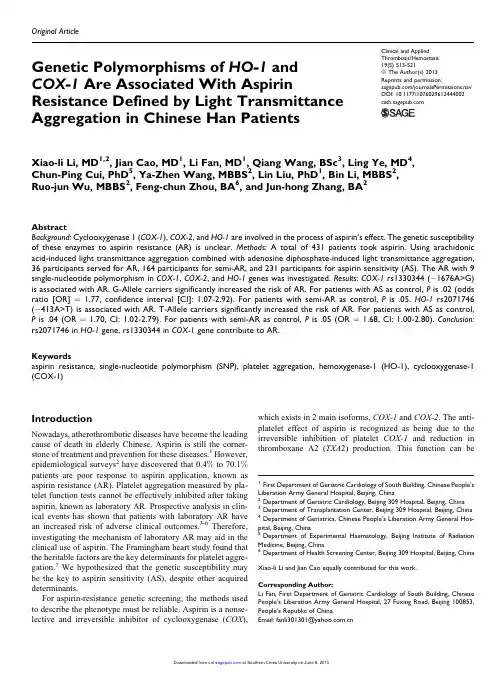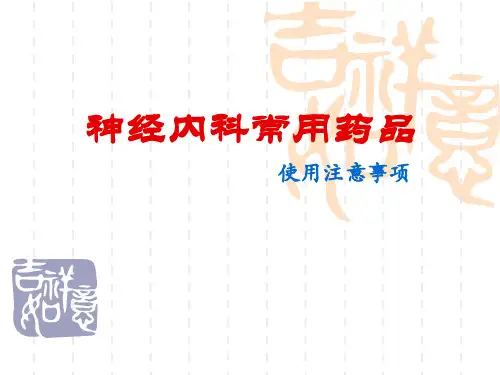阿司匹林抵抗PPT课件
- 格式:ppt
- 大小:2.62 MB
- 文档页数:20









Original ArticleGenetic Polymorphisms of HO-1andCOX-1Are Associated With AspirinResistance Defined by Light TransmittanceAggregation in Chinese Han PatientsXiao-li Li,MD1,2,Jian Cao,MD1,Li Fan,MD1,Qiang Wang,BSc3,Ling Ye,MD4,Chun-Ping Cui,PhD5,Ya-Zhen Wang,MBBS2,Lin Liu,PhD1,Bin Li,MBBS2,Ruo-jun Wu,MBBS2,Feng-chun Zhou,BA6,and Jun-hong Zhang,BA2AbstractBackground:Cyclooxygenase1(COX-1),COX-2,and HO-1are involved in the process of aspirin’s effect.The genetic susceptibility of these enzymes to aspirin resistance(AR)is unclear.Methods:A total of431patients took ing arachidonic acid-induced light transmittance aggregation combined with adenosine diphosphate-induced light transmittance aggregation, 36participants served for AR,164participants for semi-AR,and231participants for aspirin sensitivity(AS).The AR with9 single-nucleotide polymorphism in COX-1,COX-2,and HO-1genes was investigated.Results:COX-1rs1330344(À1676A>G) is associated with AR.G-Allele carriers significantly increased the risk of AR.For patients with AS as control,P is.02(odds ratio[OR]¼1.77,confidence interval[CI]:1.07-2.92).For patients with semi-AR as control,P is.05.HO-1rs2071746 (À413A>T)is associated with AR.T-Allele carriers significantly increased the risk of AR.For patients with AS as control, P is.04(OR¼1.70,CI:1.02-2.79).For patients with semi-AR as control,P is.05(OR¼1.68,CI:1.00-2.80).Conclusion: rs2071746in HO-1gene,rs1330344in COX-1gene contribute to AR.Keywordsaspirin resistance,single-nucleotide polymorphism(SNP),platelet aggregation,hemoxygenase-1(HO-1),cyclooxygenase-1 (COX-1)IntroductionNowadays,atherothrombotic diseases have become the leading cause of death in elderly Chinese.Aspirin is still the corner-stone of treatment and prevention for these diseases.1However, epidemiological surveys2have discovered that0.4%to70.1% patients are poor response to aspirin application,known as aspirin resistance(AR).Platelet aggregation measured by pla-telet function tests cannot be effectively inhibited after taking aspirin,known as laboratory AR.Prospective analysis in clin-ical events has shown that patients with laboratory AR have an increased risk of adverse clinical outcomes.3-6Therefore, investigating the mechanism of laboratory AR may aid in the clinical use of aspirin.The Framingham heart study found that the heritable factors are the key determinants for platelet aggre-gation.7We hypothesized that the genetic susceptibility may be the key to aspirin sensitivity(AS),despite other acquired determinants.For aspirin-resistance genetic screening,the methods used to describe the phenotype must be reliable.Aspirin is a nonse-lective and irreversible inhibitor of cyclooxygenase(COX),which exists in2main isoforms,COX-1and COX-2.The anti-platelet effect of aspirin is recognized as being due to the irreversible inhibition of platelet COX-1and reduction in thromboxane A2(TXA2)production.This function can be1First Department of Geriatric Cardiology of South Building,Chinese People’s Liberation Army General Hospital,Beijing,China2Department of Geriatric Cardiology,Beijing309Hospital,Beijing,China3Department of Transplantation Center,Beijing309Hospital,Beijing,China 4Department of Geriatrics,Chinese People’s Liberation Army General Hos-pital,Beijing,China5Department of Experimental Haematology,Beijing Institute of Radiation Medicine,Beijing,China6Department of Health Screening Center,Beijing309Hospital,Beijing,China Xiao-li Li and Jian Cao equally contributed for this work.Corresponding Author:Li Fan,First Department of Geriatric Cardiology of South Building,Chinese People’s Liberation Army General Hospital,27Fuxing Road,Beijing100853, People’s Republic of China.Email:fanli301301@Clinical and AppliedThrombosis/Hemostasis19(5)513-521ªThe Author(s)2013Reprints and permission:/journalsPermissions.navDOI:10.1177/1076029612444002detected by arachidonic acid(AA)-induced light transmittance aggregometry(LTA)in vitro,which is regarded as‘‘gold standard.’’8However,another study found that the adenosine diphosphate(ADP)-dependent pathway allows platelets to remain active in some aspirin-treated patients.9Thus in our study,AA-induced light transmittance aggregation combined with ADP-induced light transmittance aggregation was selec-ted for screening AR phenotype.Hemoxygenase-1(HO-1)is another enzyme that has been shown to be involved in the antithrombotic effects of aspirin.10 Therefore,we proposed that genetic variants of HO-1,in addi-tion to COX-1and COX-2,might also determine aspirin respon-siveness.The genetic polymorphisms of these3enzymes might be involved in AR.We screened these3genes for polymorph-isms looking at9single-nucleotide polymorphisms(SNPs)with the Sequenom iPlex platform.MethodsPatientsFor this study,information and DNA samples were obtained from consecutive patients who presented between April2008 and June2010and took part in physical examination every year in Chinese PLA General hospital,Beijing309hospital,and Navy General Hospital in Beijing with coronary artery disease (CAD),stroke,and peripheral arterial occlusive disease(PAOD) who had been receiving regular aspirin therapy(75-160mg daily)for at least4weeks.Inclusion criteria were!65years of age.Exclusion criteria included the use of clopidogrel,ticlo-pidine,dipyridamole,or other nonsteroidal anti-inflammatory drugs,heparin or low-molecular-weight heparin;acute vascular events;platelet count<150000000/L or>450000000/L;and hemoglobin<8g/dL.Any patients that admitted noncompliance or intermittent compliance were excluded from the analyses.The study was approved by the Scientific and Ethics Review Board of the First Geriatric Cardiology Division,Chinese PLA General Hospital(Beijing,People’s Republic of China).All patients pro-vided written informed consent before inclusion in the study.Following the screening procedures,431patients on aspirin therapy were enrolled.By the LTA diagnostic criteria detailed below,there were36patients with AR,164patients were par-tial AR or semi-AR,and231patients with AS.These3groups are comparable.Blood SamplingBlood samples were obtained from patients between7AM and9 AM,2to12hours after ingestion of the last dose of aspirin toeliminate the effects of circadian variation on platelet function. The first2mL of blood drawn by venipuncture through a21-gauge needle was discarded.Tubes that contained3.2%sodium citrate were used for LTA and1tube that contained a clavicular tilt angle difference(a mixture of citrate,theophylline,adeno-sine,and dipyridamole)was collected for the measurement of CD62P(P-selectin)and PAC-1(activated GP IIb/IIIa receptors). In addition,3conventional tubes were drawn for high-sensitivity C-reactive protein(hs-CRP),type-B natriuretic peptide,homo-cysteine(HCY),and protein C;the percentage activity of antith-rombin III(ATIII);routine measurement of blood components and blood lipids;and other biochemistry measurements.All assays were processed within2hours of blood sampling. Light Transmittance AggregationPlatelet aggregation was assessed in platelet-rich plasma at 37 C by LTA.Samples were centrifuged at800rpm for5min-utes to obtain native platelet-rich plasma.The platelet count was assessed using a standard cell counter.Platelet-poor plasma was obtained by the centrifugation of remaining blood at4000rpm at room temperature for8minutes.Aggregation was measured with a ChronoLog Aggregometer(Chronolog, Havertown,Pennsylvania).Aggregation was expressed as the maximal percentage change in light transmittance from base-line after the addition of AA(0.5mmol/L)and ADP(10m mol/ L),with platelet-poor plasma used as the reference.On the basis of this platelet aggregation assay,the definition of AR was the aggregation of!70%with10m mol/L ADP and of !20%with0.5mg/mL AA.9,11Aspirin sensitivity was indi-cated by neither of these criteria being met;AR by both cri-teria being met;only one of the2criteria met was deemed partial AR or semi-AR.Single-Nucleotide Polymorphism DetectionDNA samples were extracted from peripheral blood obtained from all the patients with AR and AS by a standard phenol–chloroform method.The SNP detection was performed by the use of the Sequenom MassARRAY iPLEX platform(Seque-nom,California and USA).12The assay consists of an initial locus-specific polymerase chain reaction(PCR),followed by single-base extension that uses mass-modified dideoxynucleo-tide terminators of an oligonucleotide primer.The PCR primers and single-base extension probes were designed by the Assay Design 3.1software from Sequenom.The genes and their respective haplotypes as well as the primer pairs and probes are listed in Table1.The SNPs were genotyped by the Sequenom MassArray system according to the instructions of the manufac-turer.The PCR was performed using iPlex chemistry according to the recommendations of the manufacturer as found in the MassArray iPlex standard operating procedure.Data analysis was performed with the MassArray Typer software version4.0. Statistical AnalysisComparisons of the continuous variables were made using the analysis of variance(ANOVA)test or Wilcoxon rank sum test, dependent upon the distribution of the data.Normal data are presented as mean+standard deviation,data of skewness dis-tribution are presented as median(Q R),Q R¼Q3ÀQ1.All SNPs evaluated in this study were tested for deviation from the Hardy-Weinberg equilibrium with the use of a chi-square test by Haploview4.2software.Genotype and allele differences514Clinical and Applied Thrombosis/Hemostasis19(5)between the SNPs used Pearson chi-square test or Fisher exact test by THESIS software.The associations between HO-1 polymorphisms,COX-1polymorphisms,and AR were ana-lyzed in logistic regression models after the adjustment of age and gender by SNPstats in Web.The odds ratio(OR)and95% confidence interval(CI)were used to estimate the associations of allele,genotype,and haplotype between the case and con-trol.P<.05was considered statistically significant. ResultsCharacteristics of the PatientsThe study analysis included431patients on aspirin therapy. Baseline clinical characteristics are shown in Table2.Based on the criteria of the AA-induced aggregation and ADP-induced aggregation,231(53.60%)patients were shown to be sensitive to aspirin,while164(38.05%)patients were clas-sified as semi-AR and36(8.35%)patients were classified as AR.These3groups were comparable.No significant differ-ences were found among the3groups with respect to age,sex, body mass index(BMI),smoking habits,alcohol,hypertension, CAD,cerebrovascular disease,PAOD,use of calcium-channel blockers,platelet count,Blood urea nitrogen(BUN),creati-nine,glucose,cholesterol,high density lipoprotein(HDL), low-density lipoprotein(LDL),HCY,hs-CRP,ATIII activity,PAC-1,and CD62P.In contrast,a significant difference was observed in those patients who take angiotensin-converting enzyme inhibitors/angiotensin receptor blockers(P¼.014) and nitrates(P¼.003).Allelic and Genotype FrequenciesThe allelic and genotypic frequencies of COX-1_rs1888943, COX-1_rs3842787,COX-1_rs5787,COX-1_rs5789,COX-1_rs5794,COX-2_rs5277,and COX-2_rs20417variants did not differ significantly among all the patients with AR, semi-AR,and AS.However,between the patients with AR and AS or with semi-AR,the frequencies of the COX-1_rs1330344variant alleles,HO-1_rs2071746variant alleles, and HO-1_rs2071746variant genotypes differed significantly (Table3).HO-1rs2071746(À413A>T)Associated With AR The T allele of HO-1in rs2071746(À413A>T)was associated with AR,when compared with not only AS patients but also with semi-AR patients(P¼.04and.05;OR¼1.70and 1.68;CI¼[1.02,2.79]and[1.00,2.80],respectively).In con-trast,the T allele in rs2071746(À413A>T)was not associated with semi-AR(P¼.94,OR¼1.01,CI¼[0.76,1.35]),whenTable1.Details of the Primers and Probes for the Candidate Genes.Gene Ref SNP Base Change Primer and ProbeCOX-1Rs1888943À8759C>T Second:ACGTTGGATGAAAGGAACCAGAGCTGGTGAFirst:ACGTTGGATGACCCTCAGAAAGCTACCTCTProbe:AGGGTGGTTGAGGTTGTTATCCRs1330344À1676A>G Second:ACGTTGGATGCACCCATCTGCACTCAAAACFirst:ACGTTGGATGTCTGATTCTGAGGTGAAGGCProbe:ccccgTGTGTGGCCCTGGCACTARs384278750C>T Second:ACGTTGGATGCTGGGTCCGCGAGCAGGAFirst:ACGTTGGATGTCTGCAGGGAGTCTCTTGCTProbe:AGGACGGGGAGCGGCRs5787323G>A Second:ACGTTGGATGTGGGAGTTTGTCAATGCCACFirst:ACGTTGGATGATAAGGTTGGAGCGCACTGTProbe:gCAATGCCACCTTCATCCARs5789709C>A Second:ACGTTGGATGTCTGTCCACAGGTAGACCTCFirst:ACGTTGGATGTCCTTAAAGAGCCGCAGTTGProbe:cctGCCACATTTATGGAGACAATCRs57941441G>A Second:ACGTTGGATGAGGGACTGCATCCAGGAAACFirst:ACGTTGGATGGGTTTGGCATGAAACCCTACProbe:ACAGCTGCTCACCTACCOX-2Rs20417À765G>C Second:ACGTTGGATGTGTTCTCCGTACCTTCACCCFirst:ACGTTGGATGAGGACCAGTATTATGAGGAGProbe:TTGTTTCTTGGAAAGAGAGGRs5277306G>C Second:ACGTTGGATGATTCCCTTCCTTCGAAATGCFirst:ACGTTGGATGGCTAAAAACCTTAGAAAGACProbe:CGAAATGCAATTATGAGTTATGTHO-1Rs2071746À413A>T Second:ACGTTGGATGTCCCAGAAGGTTCCAGAAAGFirst:ACGTTGGATGGGGTTGCTAAGTTCCTGATGProbe:AGCGCTGCTCAGAGCAAAbbreviations:Ref,reference;SNP,single-nucleotide polymorphism.Li et al515compared with patients with AS(Table3).Patients who were homozygous or heterozygous for the T allele were signif-icantly more likely to have aspirin resistance(genotype AT or TT)in the HO-1gene compared with the AA wild-type gen-otype,the AT and TT genotypes significantly increased the risk of AR,while patients with AS acting as a control,P is .0077(OR¼ 3.31,CI¼[1.24-8.83]);adjusted by age and sex,P is.0058(OR¼3.47,CI¼[1.29-9.34]).Patients with Semi-AR acting as a control,P is.0024(OR¼3.95, CI¼[1.46-10.68]);adjusted by age and sex,P is.0022 (OR¼4.03,CI¼[1.48-10.96];Table4).COX-1rs1330344(À1676A>G)AssociatedWith ARThe G allele of COX-1rs1330344(À1676A>G)was associated with AR,when compared with not only the AS patients but also with semi-AR patients(P¼.02and.05,OR¼1.77and 1.66,CI¼[1.07,2.92]and[0.99,2.77],respectively]).In contrast,the G allele of COX-1rs1330344(À1676A>G)was not associated with semi-AR,P¼.66,OR¼1.07,CI¼[0.80,1.43],when compared with patients with AS(Table3). However,the P value of genotype frequencies of COX-1Table2.Demographic Details for the Patients.Variable AR(n¼36)Semi-AR(n¼164)AS(n¼231)P Value Age,years76.33+8.8574.02+8.0373.88+8.00.234 No.of female115978.796 BMI,kg/m224.93+3.2624.93+3.9825.29+3.60.614 Weistline,cm89.68+9.7191.72+11.8191.95+11.69.689 No.of smokers114151.495 No.of drinkers63545.789 No.exercise32149208.925 No.hypertension27109165.445 No.coronary artery disease2491131.465 No.ICVD165885.592 No.PAOD61321.259 No.hyperlipoidemia145891.413 No.atrial fibrillation1310.380 No.diabetes mellitus1969106.467 No.COPD21629.381 No.CRF2913.998 No.CHF134961.434 MedicationNo.ACEIs/ARBs61546.014a Bs106384.486 No.statins164564.096 No.nitrates13263.003a Laboratory dataPlatelet count,per m L207.60+67.40209.30+59.47207.81+57.11.969 BUN,mmol/L 6.58+2.08 6.02+1.53 5.75(5.12).301b Creatinine,m mol/L83.88+25.4482.78+51.7978.67+25.15.465 UA,mmol/L325.00+107.72327.13+88.90324.66+84.79.969 Glucose,mmol/L 6.25+1.31 6.11+1.45 6.04+1.35.697 Total cholesterol,mmol/L 4.75+1.00 4.82+1.03 5.18+3.11.272 Triglyceride,mmol/L 1.78+0.92 1.63+0.72 1.57+0.70.277 HDL,mmol/L 1.28+0.38 1.27+0.34 1.34+0.37.126 LDL,mmol/L 2.82+0.80 2.85+0.79 2.30+0.91.797 HCY,m mol/L16.59+4.5216.19+7.2417.98+9.50.122 hs-CRP(mg/dL)0.22(0.27)0.24(0.23)0.22(0.31).784b ATIII activity,%101.18+16.26105.39+12.63105.13+14.68.283 NT-proBNP(pg/mL)95.10(104.13)70.10(80.00)75.10(85.05).090b PAC-1(%)43.30(53.90)46.20(45.45)41.10(51.05).097b CD62P(%) 6.60(11.70)8.50(13.85) 5.75(15.85).570b Abbreviations:BMI,body mass index;PAOD,peripheral arterial occlusive disease;AR,aspirin resistance;AS,aspirin sensitivity;ACEIs,angiotensin-converting enzyme inhibitor;ARBs,angiotensin receptor blocker;CCBs,calcium-channel blockers;HCY,homocysteine;hs-CRP,high-sensitivity C-reactive protein;ATIII, antithromibin III;BNP,type-B natriuretic peptide;ICVD,ischemic cerebrovascular disease;COPD,chronic obstructive pulmonary disease;CRF,chronic renal failure;CHF,chronic congestive heart failure;UA,uric acid;HDL,high density lipoprotein;LDL,low-density lipoprotein;NT-proBNP,N-terminal Pro-Brain Natriuretic Peptide;CD62P,P-selectin;PAC-1,activated GP IIb/IIIa receptors.a P<.05.b Skewed distribution of data.516Clinical and Applied Thrombosis/Hemostasis19(5)Table3.Distribution of SNPs in HO-1,COX-1and COX-2Genes Among the3Groups.Ref SNPAspirin Resistancevs Aspirin-SensitivityAspirin Resistance vsSemi-Aspirin ResistanceSemi-Aspirin Resistancevs Aspirin-SensitivityCase(n¼36)Control(n¼231)P Value(OR,95%CI)Case(n¼36)Control(n¼164)P Value(OR,95%CI)Case(n¼164)Control(n¼231)P Value(OR,95%CI)COX-1_rs1888943Allele.69.51.38C7246172326326461.35(0.03,3.92) T010221 2.83(0.26,31.32) Genotype.92.80.67CC3623036162162230CT010221TT000000COX-1_rs1330344Allele.02a.05a0.66A34282.56(0.34,0.93)34196.60(0.36,1.01)196282.94(0.70,1.25) G38178 1.77(1.07,2.92)38132 1.66(0.99,2.77)132178.07(0.80,1.43) Genotype.1.070.18AA993.49(0.22,1.09)956.64(0.28,1.46)56930.76(0.50,1.16) AG1696 1.12(0.55,2.27)1684.76(0.37,1.57)8496.47(0.98,2.19) GG1141 2.03(0.92,4.45)1124 2.57(1.12,5.90)2441.79(0.46,1.37) COX-1_rs3842787Allele.69.64.8G72461723253254610.71(0.04,11.31) A010111.42(0.09,22.76) Genotype.92.9.97GG3623036162162230.70(0.04,11.34) AG010111 1.42(0.09,22.87) A000000COX-1_rs5787Allele.69.34.08A010441 5.73(0.64,51.48) G7246172322322461.17(0.02,1.57) Genotype.92.8.17AA000220AG010001GG3623036161161230.35(0.032,3.90) COX-1_rs5789Allele1.64.23A000110C7246272325325462Genotype1.9.49AA000000AC000110CC3623136162162231COX-1_rs5794Allele11C72462723281328462Genotype1CC362311721641164231COX-2_rs5277Allele.1.28.46C514 2.39(0.83,6.84)513 1.79(0.62,5.18)1314 1.34(0.62,2.89) G67448.49(0.15,1.20)67311.56(0.19,1.62)3114480.75(0.35,1.61) Genotype.24.54.75CC000000CG514 2.50(0.84,7.42)513 1.85(0.61,5.56)1314 1.35(0.62,3.00) GG31217.40(0.13,1.19)31149.54(0.18,1.63)149217.74(0.34,1.62)(continued) Li et al517rs1330344and allele frequencies were not consistent(Table3). The AA,AG,and GG genotypes showed no differences among the3groups.In a recessive genetic model,compared with semi-AR,the GG genotype was significantly associated with aspirin resistance,P¼.0032,OR¼2.57,CI¼1.12-5.89, adjusted by age and sex,P¼.031,OR¼2.59,CI¼1.12-5.98(Table4).COX-1Haplotype Associated With ARSix SNPs in COX-1were selected.Both rs1888943and rs1330344are in the promoter region of COX-1gene,the other 5SNPs in the exons of COX-1gene(information from http:// /SNP).Besides rs1330344,the other SNPs are rare in the Chinese Han population(Table5).The COX-1haplotype is dominated by rs1330344.Patients who car-ried the variant haplotype CGCGCG in COX-1gene compared with the COX-1wild-type haplotype were more likely to have AR.When patients with AS act as control,P¼.032,OR¼1.69,CI¼1.05-2.71.When patients with semi-AR act as control, P¼.044OR¼1.72,CI¼1.02-2.92(Table6).COX-2Genetic Association With ARThe alleles and genotypes of rs5277and rs20417showed no differences among the3groups(Table3).The minor allele frequency of rs20417is also rare in the Chinese Han population.rmation of Selected SNPs in COX-1Gene.Ref SNP MAF MAF(NCBI)Position Protein Change rs18889430.0020.0715–8759C>Trs13303440.4040.3362–1676A>Grs38427870.0020.0636Exon2,50C>T p.Pro17Leurs57870.003Exon4,323G>A p.Arg108Gln rs57890.0010.0221Exon7,709C>A p.Leu237Met rs579400.011Exon10,1330G>A p.Val481Ile Abbreviations:Ref,reference;SNP,single-nucleotide polymorphism.Table3(continued)Ref SNPAspirin Resistancevs Aspirin-SensitivityAspirin Resistance vsSemi-Aspirin ResistanceSemi-Aspirin Resistancevs Aspirin-SensitivityCase(n¼36)Control(n¼231)P Value(OR,95%CI)Case(n¼36)Control(n¼164)P Value(OR,95%CI)Case(n¼164)Control(n¼231)P Value(OR,95%CI)COX-2_rs20417Allele1.64.23G000110C7246272323323462Genotype1.89.49GG000000CG000110CC3623136161161231HO-1_rs2071746Allele.04a.05a.94T39189 1.70(1.02,2.79)39134 1.68(1.00,2.80)134189 1.01(0.76,1.35) A33271.59(0.36,0.97)33190.60(0.36,0.99)190271.99(0.74,1.32) Genotype.04a.01a.21TT839 1.40(0.59,3.30)835 1.04(0.43,2.48)3539 1.35(0.81,2.24) AT23111 1.90(0.92,3.93)2364 2.71(1.23,5.73)64111.70(0.47,1.05) AA580.30(0.11,0.81)563.25(0.09,0.68)6380 1.19(0.77,1.81) Abbreviations:Ref,reference;SNP,single-nucleotide polymorphism;OR,odds ratio;CI,confidence interval.a P<0.05.Table4.Genotype of rs2071746(A>T)Responses to Aspirin Resistance.Group Genotype Control(%)Case(%)OR(95%CI)P Value OR Adjust(95%CI)P Value Adjust AR vs AS A>A80(34.8)5(13.90)1.00771.0058A>T-T>T150(65.2)31(86.1) 3.31(1.24-8.83) 3.47(1.29-9.34)AR vs semi-AR A>A63(38.9)5(13.9)1.00241.0022A>T-T>T99(61.1)31(86.1) 3.95(1.46-10.68) 4.03(1.48-10.96)Abbreviations:OR,odds ratio;CI,confidence interval;AR,aspirin resistance;AS,aspirin sensitivity;MAF,minor allele frequency.NCBI,National Center for Biotechnology Information.518Clinical and Applied Thrombosis/Hemostasis19(5)DiscussionThere are plenty of reports about genetic susceptibility to AR.Genetic variants of uridine 5’-diphosphate-glucuronosyltrans-ferase (UGT1A6),cytochrome P4502C9(CYP2C9),acyl-CoAsynthetase medium-chain family member 2(ACSM2),COX-1,COX-2,platelet glycoproteins GPI a ,GPIb a ,GPIIIb a ,ADP platelet receptors P2RY 1and P2RY 12,coagulation factor XIII (FXIII ),and TXA 2receptor have been reported in AR.13-17How-ever,the results are poorly reproducible perhaps due to race and different diagnostic methods.To improve the diagnostic specificity of AR,AA-induced LTA combined with ADP-induced LTA was therefore used for this study.Platelet aggregation at the sites of atherosclerotic plaque plays a role in the thrombosis.COX-1,COX-2,and HO-1are overexpressed in atherosclerotic lesions,mainly by macro-phages and endothelial cells 18,19and are involved in the process of arterial thrombosis.Due to the lack of a nuclear structure in platelets and the inducible expression properties of HO-1and COX-2,platelets do not generate COX-2and generate trace HO-1in the adult.20The COX-1,COX-2,and HO-1are all target molecules of aspirin.The difference is that COX-1is constitutively expressed in many tissues and cellsincluding platelets.The sites of action of aspirin on COX-2were deduced to be in the vascular wall,especially in athero-sclerotic plaques (Figure 1).The present study aimed to deter-mine whether previously identified SNPs of COX-1,COX-2,and HO-1are associated with laboratory AR,which was diag-nosed through platelet function test methods in vitro.The highly conserved COX-1gene serves as house-keeping gene and the function is important to life.The human COX-1gene encodes more than 20SNPs,and most of them are rare.21The COX-1gene polymorphisms are of potential importance because individual SNPs or their haplotypes may affect the action of the enzyme as well as its interaction with aspirin.22We investigated 6common SNPs of COX-1and found that the rs1330344(À1676A>G)polymorphism of the COX-1gene promoter and COX-1haplotype are significantly associated with the development of AR.The promoter À1676G allele appears to contribute significantly to an AR haplotype.The other 5SNPs are rare in Chinese Han population.The genetic differences associated with AR significantly vary with race.Data from a review by Agu ´ndez et al suggested that the alleles of COX-1associated with AR are rs3842787and rs5789for European individuals and rs3842789and rs3842792forTable 6.COX-1Haplotype Responses to Aspirin Resistance.rs1888943rs1330344rs3842787rs5787rs5789rs5794Case,Control Freq.OR (95%CI)P -Value AR vs AS C A C G C G 0.472,0.6131.032C G C G C G 0.528,0.383 1.69(1.05-2.71)AR vs semi-ARC A C G C G 0.472,0.5951.044CGCGCG0.528,0.3931.72(1.02-2.92)Abbreviations:OR,odds ratio;CI,confidence interval;AR,aspirin resistance;AS,aspirinsensitivity.Figure 1.Effects of aspirin via HO-1,COX-1,and COX-2pathways on platelet aggregation.HO-1indicates hemoxygenase-1;COX-1/2:cyclooxygenase-1/2.Li et al519African individuals.13Our research shows that rs1330344has a high prevalence in the Chinese population.The frequency of the minor allele,À1676G is0.40.The GG homozygosity is associated with AR and occurs in17.67%of the Chinese Han population(Table3).In the Japanese population,rs1330344 is also highly prevalent,theÀ1676C allele has a protective function against functional dyspepsia in Japanese women23 andÀ676A is a risk factor for aspirin-induced peptic ulcer in Japanese.24On the other hand,the T-1676C promoter poly-morphism was reported to be essential for COX-1transcription. It is,therefore,proposed that G-allele carriers upregulate COX-1expression and that low-dose aspirin may be an ineffec-tive therapy for GG homozygotes.Another SNP of COX-1, rs3842787(C50T),which demonstrates complete linkage dise-quilibrium with the other polymorphism A-842G,is found with minor frequency in Caucasians(8.6%).The C50T Pr –Leu allele, which is present in the signal peptide at position17,has been depicted as a determinant of pharmacological response to aspirin treatment.However,our study showed the frequency of the minor allele in rs3842787(50C>T),which was markedly lower(0.2%)in Chinese than in Caucasians.The same result was reported in the Japanese.In our study,the frequency of the minor allele in rs5789(709C>A)was also markedly lower (0%).Moreover,between the Chinese and Japanese popula-tions,the gene differences for COX-1are highly consistent. Thus,rs1330344may be a common tag SNP in COX-1gene associated with aspirin resistance in Asians.Unlike COX-1,COX-2is an induced enzyme,and COX-2 messenger RNA and protein synthesis are induced in a time-and dose-dependent manner in inflammation by endothelial cells and macrophages.Atherosclerosis is now understood to be a disease characterized by inflammation,with chronic inflammation involved at every stage,from initiation to pro-gression and,eventually,plaque rupture.25Aspirin is known to exert its anti-inflammatory effects via COX-2.A study by Patrignani et al26found that COX-2is not involved in throm-boxane biosynthesis by activated human platelets and conse-quently argue against the involvement of COX-2-dependent pathway in AR.Our results showed that2common genetic var-iations rs5277and rs20417in COX-2gene are not associated with AR in the Chinese Han population.The rs5277is also a tag SNP for COX-2,as aspirin is a weak COX-2inhibitor and the low-dose aspirin perform antiplatelet effect than anti-inflammation.So we deduced that COX-2gene may not con-tribute to the pathogenesis of AR in Chinese Han population.Similar to COX-2,HO-1is the inducible enzyme that is ubi-quitously distributed in mammalian tissues and is upregulated by diverse stimuli,which include inflammatory cytokines and factors that promote oxidative stress.Recent studies have found that HO-1is a target in the mediation of aspirin-dependent cytoprotective and anti-inflammatory effects.27-29The HO-1 is the rate-limiting enzyme in the oxidative degradation of heme to biliverdin,free iron,and carbon monoxide.The effects of HO-1are mediated by its metabolites.30The HO-1plays an important role in many aspects of human physiology as well as in pathological events such as atherosclerosis.Reports have demonstrated that the c-Jun N-terminal kinase/activator protein-1(AP-1)signaling pathway is crucially involved in the anti-inflammatory mechanism of HO-1associated with aspirin27and that the cytoprotective action of HO-1associated with aspirin is mediated by the nitric oxide/Cyclic Guanosine Monophosphate(NO/cGMP).system in the endothelium.31 Aspirin induces HO-1expression in endothelial cells in a COX-independent manner.28In2004,Peng et al showed that the induction of HO-1expression inhibited platelet-dependent thrombosis through its metabolite.Our study sug-gests that HO-1has an impact on platelet aggregation and that a genetic polymorphism is associated with AR.Studies have shown that the major mammalian stress-responsive transcription factors,heat-shock factor,nuclear factor-erythroid2,AP-1,and the nuclear factor-k B family mem-bers,all regulate the HO-1gene through binding with the sites located within the HO-1promoter region and increase HO-1 transcription.32,33These findings suggest that the structure of the promoter region is vital to gene expression of HO-1.Determin-ing the association between HO-1polymorphism and AR was a focus of this study.At present,2functional polymorphisms in the HO-1promoter region,a(GT)n microsatellite and rs2071746(À413T>A)can regulate transcription capability of HO-1.33Both a short(GT)n allele and the A-allele have been associated with increased HO-1promoter activity.Our data for the first time have shown that AT and TT genotypes of the HO-1promoter polymorphism rs2071746(À413A>T)are asso-ciated with susceptibility to AR.In fact,gene changes in the HO-1promoter that impact on aspirin responsiveness are not unique;many studies have demonstrated their impact in a variety of disease states,such as CAD,Alzheimer disease,Parkinson disease,cancer,organ transplantation,infection,diabetes mel-litus,autoimmune disorder,and acute respiratory distress syn-drome.We presume that more evidence will be discovered about the associations of the HO-1gene polymorphism and dis-ease,owing to the property of HO-1being a ubiquitous cell-defensive enzyme.The HO-1seems to be an integral part of the stress response,34and the failure to respond to stressful stimuli via HO-1induction leads to increased susceptibility to diseases. ConclusionWe examined the association of genetic polymorphisms with laboratory aspirin resistance determined by AA-induced LTA combined with ADP-induced LTA.Our study demonstrated for the first time that rs2071746(À413A>T)gene polymorphism in HO-1and rs1330344(À1676A>G)gene polymorphism in COX-1are significantly associated with AR in the elderly Chi-nese Han population.The rs1330344is a fairly common allele in the Han population.We were unable to find an association with a COX-2polymorphism.These findings may guide aspirin antithrombotic therapy in China.Declaration of Conflicting InterestsThe author(s)declared no potential conflicts of interest with respect to the research,authorship,and/or publication of this article.520Clinical and Applied Thrombosis/Hemostasis19(5)。

